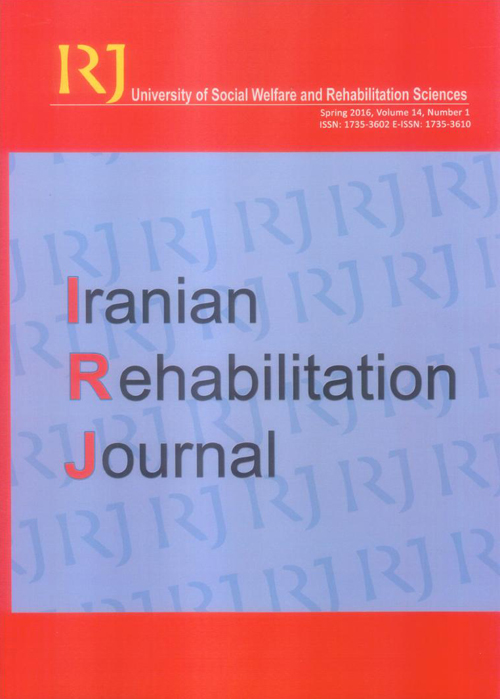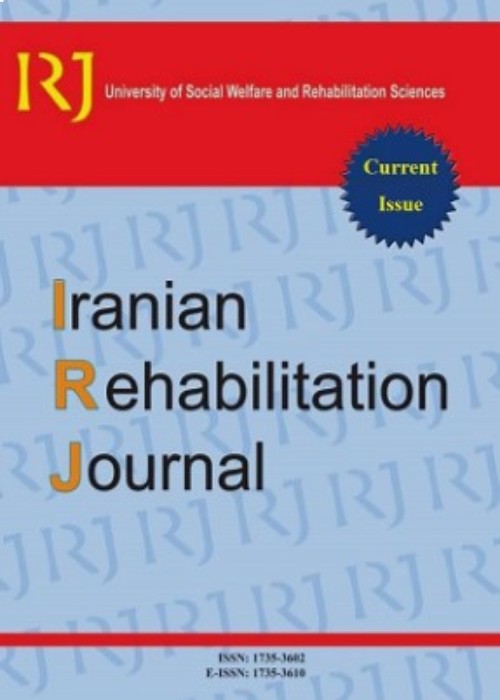فهرست مطالب

Iranian Rehabilitation Journal
Volume:14 Issue: 27, Mar 2016
- تاریخ انتشار: 1395/01/08
- تعداد عناوین: 11
-
-
Pages 3-4
-
Pages 5-14The vestibular system is important for the development of normal movement reactions, motion tolerance, and motor control for postural alignment, balance, and vision. A vestibular system that is damaged by disease or injury in childhood can have a major impact on a childs development. In addition, the emergence of vestibular lesions may also lead to cognitive deficits, including attention deficit. Despite the advances in testing and documentation of vestibular deficits in children, the vestibular problems continue to be an overlooked entity. Many children do not receive treatment that could significantly improve function and address the developmental delays caused by vestibular disorders.
Vestibular rehabilitation therapy (VRT) has been defined as an effective modality for most individuals with disorders of the vestibular or central balance system disorders. The basis for the success of VRT is the use of existing neural mechanisms in the human brain for adaptation, plasticity, and compensation. The vestibular system cannot be considered as a separate entity ignoring other balance subsystems. Hence, a modified VRT program, named pediatric balance therapy with special modifications in exercises, was developed for children with vestibular disorders, in accordance to the whole balance system.Keywords: Children, Vestibular Rehabilitation, Balance, Vestibular -
Pages 15-22ObjectivesLow back pain is one of the main health problems which affect many people worldwide. The daily course of life is highly disrupted due to the chronic back pain problem. This study aims to explore the occupational performance of individuals with chronic low back pain.MethodsFifteen people with chronic low back pain were included in this study using purposeful sampling. The participants were interviewed, and a qualitative content analysis was employed to analyze the data.ResultsThe three main resulted themes were: 1) Occupational disturbance because of low back pain; 2) Difficulty in moving around and remaining in any given position; and 3) Permanent mind struggle owing to back pain. People with chronic low back pain experience difficulty in all areas of daily occupation including self-care, work, and leisure, plus having trouble with being physically active and being persistent in certain positions. Furthermore, mind struggle with back pain which implies preoccupation with back pain in addition to fear of movement are other findings of present study.DiscussionChronic low back pain greatly influences the daily occupations of individuals. Mind struggle with back pain, which implies preoccupation with back pain, in addition to the fear of movement are significant findings of the present study. Occupational therapists can play an important role in re-engagement of people with chronic low back pain in their daily occupations.Keywords: Daily occupation, Chronic low back pain, Qualitative study, Occupational performance
-
Pages 23-30ObjectivesTo investigate the clinical efficacy of physiotherapy with and without superficial dry needling on patients with knee pain; patellofemoral pain syndrome.MethodsA randomized clinical trial conducted in 2015, Tehran, Iran. Of patients with patellofemoral pain syndrome, thirty-four subjects were randomly divided into two groups (17 in each group). Group A was subjected to physiotherapy and group B to physiotherapy with superficial dry needling. Only for group B, superficial dry needling was applied during the ten-day sessions of physiotherapy, every other day. The needle remained for 6 minutes at threepoints of the quadriceps muscle, accompanied with needle rotation. Both groups received 10 therapy sessions. For both groups, in the first and tenth sessions, knee pain and quadriceps muscle strength was evaluated.ResultsStatistical analysis showed the two variables in each group had significant improvements after the 10 sessions (PDiscussionPhysiotherapy with and without superficial dry needling were seen to reduce pain and increase muscle strength of patients with patellofemoral pain syndrome. However, performing physiotherapy with superficial dry needling had a more significant effect on reducing knee pain. Superficial needling can cause many physiological and neurophysiological effects. Through stimulation of pain control mechanisms, it can help in further reduction of pain.Keywords: Pain, Muscle strength, Knee joint, Physiotherapy, Needles, Clinical trial
-
Pages 31-34ObjectivesAnkle Foot Orthoses (AFOs) are widely utilized to improve walking ability in hemiplegic patients. The present study aimed to evaluate the effect of Rocker bar Ankle Foot Orthosis (RAFO) on functional mobility in post-stroke hemiplegic patients.MethodsFifteen hemiplegic patients (men and women) who were at least 6-months poststroke and able to walk without an assistive device for at least 10 meters voluntarily participated in this study. The patients were examined for three conditions: shoes only, with SAFO and with RAFO. Their functional mobility was evaluated through 10-meter walk test and Timed Up and Go (TUG) test. In addition, paired t-test was used to analyze the obtained data.ResultsWhen the patients used RAFO, their gait speed significantly increased (PDiscussionRAFO led to a significant improvement in functional mobility in hemiplegic patients post stroke. This may be due to the positive effect of rocker modification on improving push off and transferring weight during the stance phase of gait.Keywords: Rocker bar ankle foot orthosis, Functional mobility, Hemiplegic patients
-
Pages 35-42ObjectivesThis study examined the relationship between working and short-term memory performance, and their effects on cochlear implant outcomes (speech perception and speech production) in cochlear implanted children aged 7-13 years. The study also compared the memory performance of cochlear implanted children with their normal hearing peers.MethodsThirty-one cochlear implanted children with a mean age of 121.52 months (~ 10 years) and SD=19.946 and 31 normal hearing children with a mean age 120.68 months (~ 10 years) and SD=18.137 participated in this study. Their memory performance was assessed by Working Memory Test Battery for Children (1), speech perception was measured by Categories of Auditory Performance (2), and their speech production was assessed by Speech Intelligibility Rating (3). Finally, the data were analyzed using SPSS through its descriptive variables MANOVA and Spearman Correlation Coefficient.ResultsA significant and positive correlation was observed between working memory performance and cochlear implant outcomes. In addition, the children using cochlear implants had poorer performance compared to their normal hearing peers.DiscussionThis study demonstrated that the memory performance of children using cochlear implants has a significant effect on their speech productionKeywords: Memory, Speech perception (CAP), Speech production (SIR), Working memory test battery for children (WMTB, C), Cochlear implant
-
Pages 43-50ObjectivesThis study investigates the impact of neurofeedback on perceptual-motor skills of 5 to 12 years old children with Attention Deficit Hyperactive Disorder (ADHD).MethodsIn this clinical study, 40 children between the ages of 5-12 years, who were patients of the Tavanesh Clinic and diagnosed with ADHD, were randomly chosen and divided into two groups of control and test. 20-neurofeedback intervention sessions were performed. The tools utilized in this study included BruninksOseretsky Test of Motor Proficiency and Child behavior checklist (CBCL) survey questionnaire. For evaluation after the intervention, BruninksOseretsky Test of Motor Proficiency scale for children, along with CBCL questionnaire surveys were asked to fill up by the participants mothers.ResultsAfter the intervention, the analysis of the scores in all perceptual-motor skills showed significant differences in both groups, but no significant difference was observed in the subtest of strength. The CBCL survey questionnaire revealed that the average scores on attention disorder, aggression, lack of attention and hyperactivity, externalizing and general problems in the test group is significantly less than that of the control group. However, in the confrontational behavior (internalization), there was no statistically significant difference between the test and control groups. There was a correlation between the change of motor skills and change of behavioral patterns in ADHD children.DiscussionNeurofeedback intervention can have positive effects on improving the perceptualmotor skills of children with ADHD.Keywords: Attention deficit disorder with hyperactivity, Neurofeedback, Perceptual, motor skills
-
Effectiveness of Cognitive-Behavioral Group Therapy on Self-Concept of Visually Impaired AdolescentsPages 51-58ObjectivesThe present study has been conducted to determine the effectiveness of cognitivebehavioral group-therapy on the development of visually impaired adolescents self-concept.MethodsThis study is a semi-experimental pre-test and post-test model. The study population consisted of visually impaired male students of the primary and secondary high school at the Omid-e-Mashhad Educational Center for the Blind in the 2014-2015 academic year. Becks Self-Concept Scale was used as a research tool, and 20 students with scores one deviation standard below the mean were randomly selected and divided into experimental and control groups. The experimental group received nine weekly sessions of cognitive-behavioral therapies, each of 90 minutes. The post-test data analysis was performed by conducting SPSS using descriptive statistics methods (mean and standard deviation for the study variables and tables) and inferential statistics methods (including Kolmogorov-Smirnov test, t-test for independent groups, Lewin test, and co-variance test).ResultsThe results of covariance analysis revealed that the intervention of cognitive behavioral group counseling can significantly increase the self-concept among the participants of the experimental group.DiscussionCognitive-behavioral group counseling sessions can improve the self-concept of visually impaired adolescents. Moreover, positive self-concept will increase their social interaction and mental health.Keywords: Self, concept, Visually impaired, Cognitive, behavior counseling
-
Pages 59-62ObjectivesThe Gradual Increase Length and Complexity of Utterance (GILCU) therapy method is a form of operant conditioning. This is a precise and controlled treatment that is done in 54 steps in 3 speech situations consisting of monologue , reading, and conversation. This study aimed at examining the effects of GILCU treatment method on the reduction of speech dysfluency of school-aged children with stuttering.MethodsIn this quasi-experimental study, 32 children with stuttering (6-11 years old) who were referred to speech therapy clinics were selected using convenience sampling. Then, they were assigned into two groups. The first group was treated by GILCU therapy method by the researcher, and the second group was treated by traditional methods by another speech therapist. Both groups had fourteen 45-minute sessions that were conducted one to two times per week. Pre-test and post-test of both groups were assessed using the SSI-3 scores. The obtained data were analyzed using the Kolmogorov-Smirnov, t-test, and covariance test.ResultsBoth groups had statistically significant difference (P0.005) with respect to parameters of SSI-3 scores.DiscussionThese results suggest that a non-programming treatment for stuttering may be effective with school-aged children who stutter.Keywords: Gradual increase in length, complexity of utterance (GILCU), Dysfluency, SSI, 3, School, aged children
-
Pages 63-68ObjectivesAll individuals need to have the ability of appropriate sensory processing for proper functioning in the environment and participation in daily activities. Moreover, behavioral functions can be affected by sensory processing problems. This study aimed to determine the relationship between behavioral problems and sensory processing in 7 to 10 years old children with Attention Deficit/Hyperactivity Disorder (ADHD).MethodsThis descriptive (cross-sectional) study included 60 children with ADHD aged 7 to 10 years, who were referred to a comprehensive psychiatric center. Short Sensory Profile (SSP) and Child Behavior Checklist (CBCL) questionnaires were used for assessing the patterns of sensory processing and behavioral problems in the patients.ResultsThere was a negative correlation between internalizing behavioral problems (r=−0.426) and externalizing behavioral problems (r=−0.465), and the total score of sensory processing in ADHD children (PDiscussionThe findings of this study showed that some behaviors in children with ADHD could be due to certain defects in their sensory processing.Keywords: Sensory perception, Attention deficit, hyperactivity disorder (ADHD), Behavioral problem
-
Pages 69-73ObjectivesNew cognitive theories of delusions have proposed that deficit or bias in inference stage (a stage of normal belief formation) is significant in delusion formation. The aim of this study was predicting the severity of delusions based on jumping-to-conclusion bias in patients with schizophrenia.MethodsThe sample consisted of 60 deluded patients with schizophrenia who were selected from the Ebnesina and Razi hospitals in Shiraz using convenience sampling method. The Similarity Task was used to measure the jumping-to-conclusion biases.ResultsIts results have shown that the jumping-to-conclusion biases could predict a great part of the variance of delusions.DiscussionThese results generally indicated that the jumping to conclusion biases may provide a more useful explanation for the delusion formation.Keywords: Jumping–to, conclusion bias, Delusion, Similarity task


